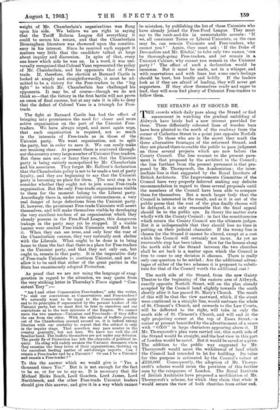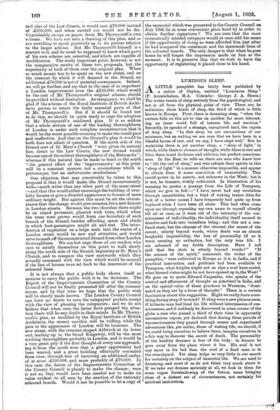THE STRAND AS IT SHOULD BE.
MHE crowds which daily pass along the Strand or find amusement in watching the gradual unfolding of Aldwych have lately had a new interest provided for them. Three differently coloured lines of wooden bars have been planted to the north of the roadway from the corner of Catherine Street to a point just opposite Norfolk Street. To those who are in the secret they mark the three alternative frontages of the reformed Strand, and they are placed there to enable the public to pass judgment on three several projects which are now before the County Council. The line nearest to the present pave- ment is that proposed by the architect to the Council ; the line furthest from the present pavement is that pro- posed by Mr. Thornycroft, the Academician ; the inter- mediate line is that suggested by the Royal Institute of British Architects. The Improvements Committee of the Council have very properly deferred making any definite recommendation in regard to these several proposals until the members of the Council have been able to compare them for themselves. But a much larger body than the Council is interested in the result, and as it is out of the public purse that the cost of the plan finally chosen will be defrayed, it is only reasonable that the final appeal should be to the public eye. In theory the matter rests wholly with the County Council ; in fact the constituencies which return the County Council are the ultimate judges. But it is indispensable that they should lose no time in putting on their judicial character. If the wrong line is chosen for the Strand it cannot be altered, except at a cost which the Council will certainly not incur. As yet no irrevocable step has been taken. How far the houses along the north side of the Strand between the two churches shall be set back is a matter upon which the Council is free to come to any decision it chooses. There is really only one question to be settled : Are the additional advan- tages of either of the two schemes it is proposed to substi- tute for that of the Council worth the additional cost ?
The north side of the Strand, from the new Gaiety Theatre to the beginning of the eastern arm of Aldwych, exactly opposite Norfolk Street, will on the plan already accepted by the Council bend slightly towards the south shortly after it has passed St. Mary's Church. The result of this will be that the view eastward, which, if the street were continued in a straight line, would embrace the whole of St. Clement's Church, and onwards to the Law Courts, will be deflected to the right, will take in only the south side of St. Clement's Church, and will end at the ugly projecting corner at the top of Essex Street,—a corner at present beautified by the advertisement of a sauce with " OX0 " in large characters appearing above it. If Mr. Thornycroft's plan were carried out, this north side of the Strand would be straight, and the best view in this part of London would be saved. But it would be saved at a price. The addition to the public wav suggested by Mr. Thornycroft would mean the withdrawal of land which the Council had intended to let for building. Its value for this purpose is estimated by the Council's valuer at £850,000. Consequently, the adoption of Mr. Thorny- croft's scheme would mean the provision of this further sum by the ratepayers of London. The Royal Institute of British Architects have proposed a modification of Mr. Thornycroft's scheme, for which they claim that while it would secure the view of both churches from either end, and also of the Law Courts, it would cost £70,000 instead of £350,000, and when carried out would not be dis- tinguishable, except on paper, from Mr. Thornycroft's own scheme. We have not seen a drawing of this plan, and so are unwilling to speak positively as to its precise relation • to the larger scheme. But Mr. Thornycroft himself is a convert to it, and he must be supposed to know which parts of his own scheme are essential, and which are capable of modification. The really important point, however, is not the comparative merits of these two proposals, but the superiority of both of them over the original plan. When so much money has to be spent on the new street, and on • the crescent by which it will descend to the Strand, an additional £70,000 is not of material consequence. Indeed, we will go further, and say that in the case of so important a London improvement even the £350,000, which would be the cost of Mr. Thornycroft's original scheme, should be provided without hesitation. As ratepayers, we shall be glad if the scheme of the Royal Institute of British Archi- tects proves to retain the really essential parts of that of Mr. Thornycroft's. But if it should be found not to do this, we should be quite ready to urge the adoption of Mr. Thornycroft's unaltered plan. It is so seldom that a whole section of one of the leading thoroughfares of London is under such complete reconstruction that it would be the worst possible economy to make the result poor and ineffective. And that on the Council's plan it would be both does not admit of question. If the north side of the Strand east of St. Mary's Church "were given its natural line, direct to the Law Courts, the new Strand would become one of the noblest thoroughfares of the Metropolis " ; whereas if this natural line be made to bend to the south " the general effect of the 'improvements' at this point will be a constant eyesore, not a crookedness which is picturesque, but an unfortunate crookedness."
• One objection that may conceivably be taken to this proposal is that it would make.the Strand inconveniently wide—much wider than any other part of the same street —and that this would either encourage the building of over- lofty houses or give a dwarfed appearance to houses of more ordinary height. But against this must be set the circum- stance that the change would give occasion for a new feature in London streets. Between the two churches there might be an island pavement, planted with trees, which when the trees were grown would form one boundary of each branch of the Strand, besides affording space and shade in which foot-passengers might sit and rest. The intro- duction of vegetation on a large scale into the centre of a London street would be new and attractive, and would serve to mark off the reconstructed Strand from other London thoroughfares. We can but urge those of our readers who care to satisfy themselves on this point to walk slowly along the north side of the Strand, beginning at St. Mary's Church, and to compare the view eastwards which they actually command with the view which would be secured if the line of houses were set back to the innermost of the coloured lines.
. It is not always that a public body shows itself so anxious to carry the public with it in its decisions. The Report of the Improvements Committee of the County Council will not be finally presented till after the summer recess, and by that time we hope that the public wish will be clearly made known. The London County Council pan have no desire to save the ratepayers' pockets except with the view of pleasing the ratepayers ; and we do not believe that when once the latter have grasped the situa- tion there will be any doubt in their minds. In Mr. Thorny- croft's plan, as modified by the Royal Institute of British Architects, the money sacrifice will be trifling, while the gain to the appearance of London will be immense. The new street, with the crescent-shaped Aldwych at its lower end, leading up to the broad Kingsway, will be the most striking thoroughfare probably in London, and it would be a very great pity if the first thought of every one approach- ing it from the south were that a great opportunity had • been wasted, and a great building effectually concealed from view, through fear of incurring an additional outlay of at most £350,000, and more probably of .270,000. In this case the desire of the Improvements Committee of the County Council is plainly to make the change ; were it not so, they would have been careful not to make its value evident to all men by the erection of the variously coloured board's. Would it not be possible to let a copy of the memorial which was presented to the County Council on July 13th lie in some convenient place hard by in order to obtain further signatures ? We are sure that the most economically minded ratepayer would at once add his name if the opportunity of doing so were afforded him just after he had compared the outermost and the innermost lines of the coloured boards. The only danger is that when he goes home he will forget the impression made on him at the moment. It is to preserve this that we wish to have the opportunity of registering it placed close to his hand.







































 Previous page
Previous page